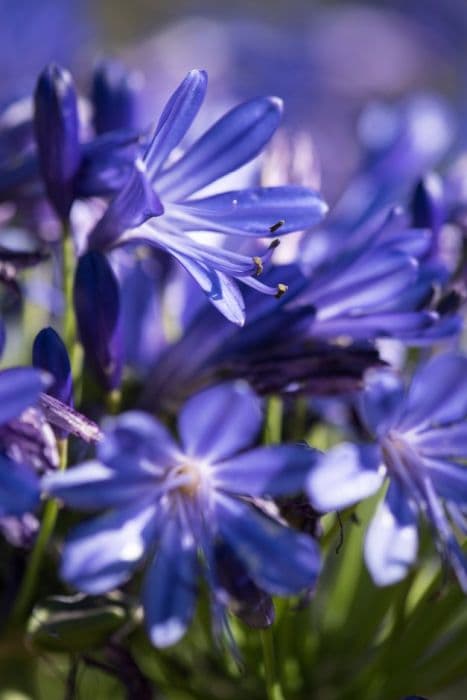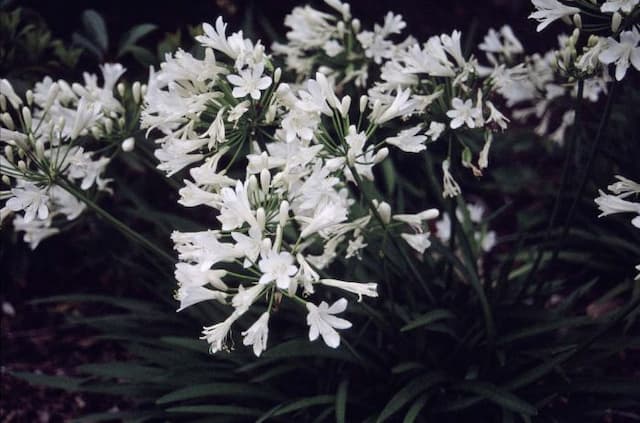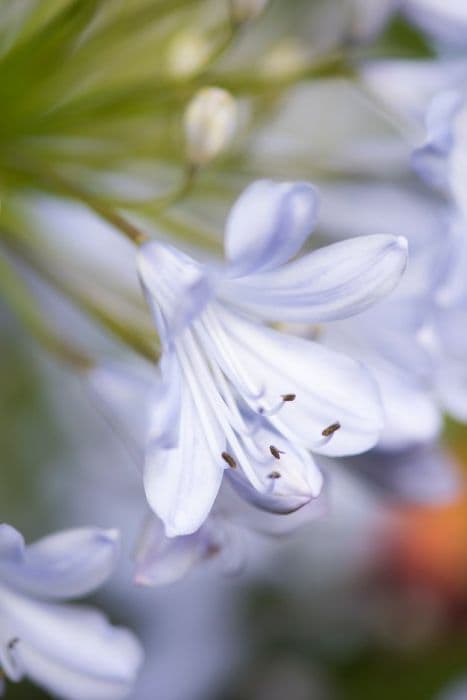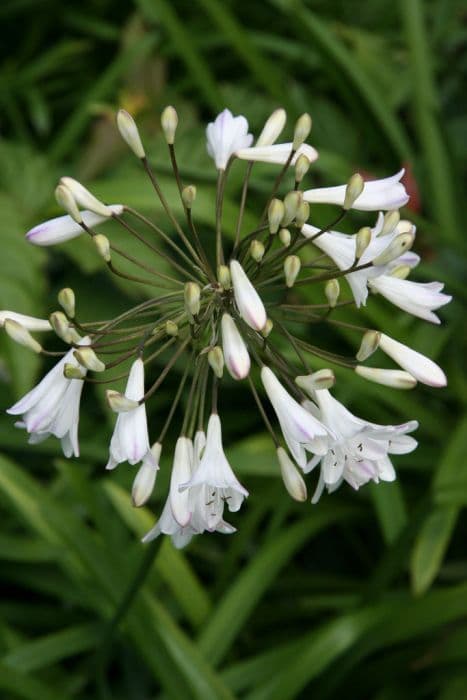Lily of the Nile Agapanthus 'Rhone'

ABOUT
The Agapanthus 'Rhone', commonly known as the Lily of the Nile or African Lily, is a striking perennial plant with notable ornamental appeal. It features lush, strap-shaped, dark green leaves that create a dense and arching foliage clump. From this tufted base, sturdy, upright stems emerge, topped with large, rounded clusters of trumpet-shaped flowers. The flowers are typically a deep blue or violet color, adding a vibrant splash of color to the ensemble. These blooms, gathered densely in spherical umbels, create an eye-catching display that is often compared to fireworks due to their shape and the way they seem to burst from the stem tips. Overall, the Lily of the Nile 'Rhone' presents as a robust and attractive plant with a lush, green base and vividly hued blooms that captivate the eye.
About this plant
 Names
NamesFamily
Amaryllidaceae
Synonyms
Lily of the Nile, African Lily
Common names
Agapanthus 'Rhone'
 Toxicity
ToxicityTo humans
Lily of the Nile or Agapanthus 'Rhone' is known to contain toxic compounds that can be harmful if ingested. Although it may not be severely toxic, consuming parts of the plant can lead to symptoms such as nausea, vomiting, and diarrhea. There is also a potential risk for allergy or skin irritation from contact with the sap. It is advised to handle this plant with care, and not to ingest any part of it to avoid these potential consequences.
To pets
Lily of the Nile, also known as Agapanthus 'Rhone' is toxic to pets, including both cats and dogs. If a pet ingests any part of the plant, it can lead to symptoms such as vomiting, diarrhea, and drooling. In some cases, more severe symptoms could occur, such as difficulty breathing or swallowing, and even tremors or convulsions. It is important to prevent pets from accessing this plant and to seek veterinary care immediately if you suspect your pet has ingested any part of it.
 Characteristics
CharacteristicsLife cycle
Perennials
Foliage type
Evergreen
Color of leaves
Green
Flower color
Blue
Height
3 feet (0.91 meters)
Spread
2 feet (0.61 meters)
Plant type
Bulb
Hardiness zones
8
Native area
South Africa
Benefits
 General Benefits
General Benefits- Ornamental Appeal: The Agapanthus 'Rhone' offers stunning blue-purple blooms, which are highly ornamental and commonly used in landscape design.
- Drought Tolerance: Once established, it is relatively drought-tolerant, making it suitable for xeriscaping and low-water gardens.
- Low Maintenance: It requires minimal upkeep beyond occasional watering and the removal of spent flowers or dead foliage.
- Attracts Pollinators: The flowers attract bees, butterflies, and other pollinators, supporting biodiversity in the garden.
- Long Blooming Season: The Agapanthus 'Rhone' has a long flowering period which can last through the summer, providing extended visual interest.
- Architectural Structure: The strappy leaves and tall flower stalks add structural interest to garden beds and borders.
- Container Gardening: Suitable for growing in pots, it can decorate patios, balconies, and other outdoor living spaces.
- Cut Flowers: Its flowers are excellent for cutting and can be used in floral arrangements, adding elegance and color indoors.
- Deer Resistance: Often resistant to deer, making it a good choice for gardens in areas where deer are a problem.
 Medical Properties
Medical PropertiesThis plant is not used for medical purposes.
 Air-purifying Qualities
Air-purifying QualitiesThis plant is not specifically known for air purifying qualities.
 Other Uses
Other Uses- Floral Art: The Agapanthus 'Rhone', also known as African Lily, can be used in floral arrangements and is valued for its long stalks and vibrant blue to violet flowers that add height and color to any composition.
- Photography Prop: Photographers occasionally use the African Lily as a subject or backdrop in botanical photography due to its striking form and color.
- Wedding Décor: The beauty and elegance of the African Lily make it a popular choice for wedding bouquets, table centerpieces, and venue decorations.
- Erosion Control: When planted in groups, African Lilies can help stabilize slopes and prevent soil erosion because of their robust root system.
- Fabric Dyeing: The pigments in the flowers of the African Lily may be used in natural fabric dyeing processes to attain shades of blue and purple.
- Cultural Symbolism: In certain cultures, the African Lily is used in ceremonies and rituals as it can represent love, fertility, or purity.
- Education: Agapanthus 'Rhone' serves as an educational tool in botany and horticulture classes, teaching students about plant growth, reproduction, and hybridization.
- Garden Borders: The plant's strappy leaves and height are perfect for creating defined borders in garden designs.
- Companion Planting: African Lily can be planted alongside other mid-summer bloomers to create a synchronized blooming period in the garden.
- Container Gardening: Due to its manageable size, the Agapanthus 'Rhone' can be used in container gardens, where it adds a dramatic display on patios or balconies.
Interesting Facts
 Feng Shui
Feng ShuiThe Agapanthus, commonly known as Lily of the Nile, is not specifically used in Feng Shui practice.
 Zodiac Sign Compitability
Zodiac Sign CompitabilityThe Lily of the Nile is not used in astrology practice.
 Plant Symbolism
Plant Symbolism- Love Letters: The name Agapanthus comes from the Greek words 'agape' meaning love and 'anthos' meaning flower. Therefore, it is often associated with love and can symbolize a love letter or a message of affection.
- Beauty: With its striking blue to violet flowers, Agapanthus is commonly associated with beauty and attractiveness.
- Endurance and Survival: Agapanthus plants are known for their hardiness and ability to thrive in various conditions. They symbolize endurance and the ability to survive and flourish through difficulties.
- Fertility: Because of their lush, plentiful blooms, Agapanthus can also be symbolic of fertility and abundance.
- Freedom: The long stems and open blooms of the African Lily may represent freedom and openness to the world.
- Home: African Lily is often planted to signify creating a welcoming environment, hence symbolizing home and hearth.
 Water
WaterFor the African Lily, water thoroughly once a week, ensuring that the soil becomes evenly moist but not waterlogged. During the growing season in spring and summer, increase watering frequency to twice a week. Provide approximately one gallon of water for outdoor plants or 16 ounces for potted specimens each time you water. Cut back on watering in the winter months, allowing the soil to dry out slightly before watering again.
 Light
LightAfrican Lilies thrive in full sun conditions where they can receive at least six hours of direct sunlight daily. The best spot for these plants is in a south-facing garden or a sunny window for indoor plants. They can tolerate partial shade but will flower best with ample sunlight.
 Temperature
TemperatureThe African Lily fares best in temperatures between 60°F and 80°F. They can survive temperatures down to 50°F but should be protected from frost, which can damage the plant. The ideal growing conditions are in warm, temperate environments without extreme fluctuations in temperature.
 Pruning
PruningAfrican Lilies should be pruned to maintain their shape and encourage new growth. Deadheading the spent flowers will promote further blooming. Pruning is best done after flowering, generally in late summer or early fall. Cut back up to one-third of the plant if necessary to remove any dead or damaged foliage.
 Cleaning
CleaningAs needed
 Soil
SoilLily of the Nile requires well-draining soil with moderate fertility and a pH range of about 6.0 to 8.0. A mix of two parts loam, one part perlite or sand, and one part compost or well-rotted manure creates an ideal growing medium for healthy root growth and adequate drainage.
 Repotting
RepottingLily of the Nile should be repotted every 2 to 3 years. As it prefers to be somewhat root-bound, choose a pot that is just one size larger than the current one to allow for growth without providing too much space, which can lead to excess moisture retention.
 Humidity & Misting
Humidity & MistingLily of the Nile thrives in average humidity levels, typical of outdoor conditions. Indoors, it does not require special humidity adjustments but should be kept in a well-ventilated area away from dry, hot air, which could cause the tips to brown.
 Suitable locations
Suitable locationsIndoor
Place in bright, indirect light and avoid overwatering.
Outdoor
Plant in full sun or partial shade and protect from frost.
Hardiness zone
8-11 USDA
 Life cycle
Life cycleThe Agapanthus 'Rhone', commonly known as Lily of the Nile, begins its life as a seed that, once germinated, develops into a small seedling. The seedling grows into a vegetative state, forming strap-like leaves and a fleshy root system. Over time, the plant matures and forms a clump with multiple leaf fans. During the flowering stage, Lily of the Nile produces tall, striking flower stalks topped with spherical clusters of blue or purple flowers in summer. After pollination, these flowers give way to seed pods if conditions allow, which eventually dry and release seeds for the next generation. In colder climates, the plant may die back in the winter and re-emerge in the spring, completing its perennial cycle.
 Propogation
PropogationPropogation time
Spring-Early Summer
The most popular method of propagating the Agapanthus 'Rhone', commonly known as the Lily of the Nile, is through division. This is usually done in the spring before new growth begins or in the late summer after the blooms have faded. To propagate by division, carefully lift the clump of the plant with a shovel and gently separate the rhizomes by hand or with a knife. Each division should have at least one or two growing points or shoots. Plant the divisions immediately in well-draining soil, ensuring that they are spaced at least 18 inches (about 45 centimeters) apart to allow for growth. Water the new plants thoroughly to help establish their roots.









![African lily [Blue Storm]](/_next/image?url=https%3A%2F%2Fplants-admin.emdemapps.com%2Fimages%2Fplants%2F%2Fimages%2F604b63200a08b.png&w=640&q=75)